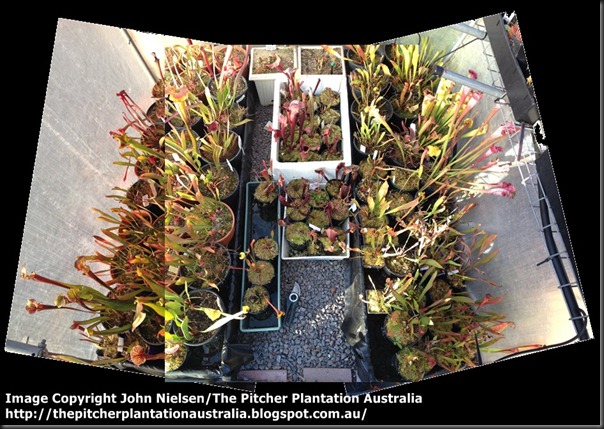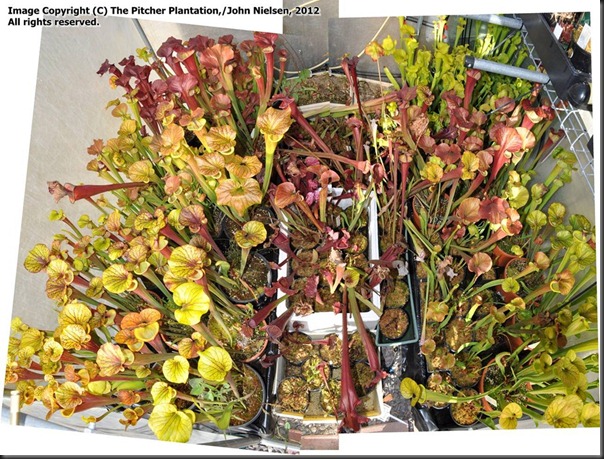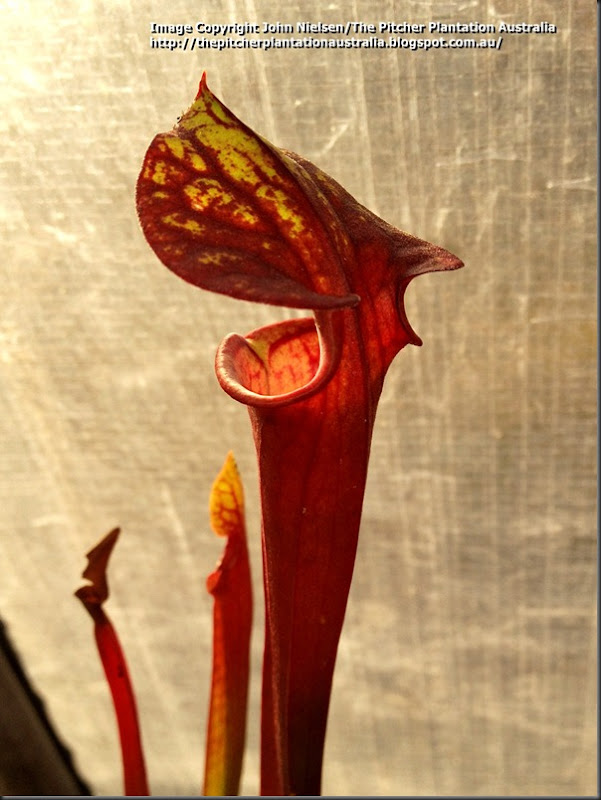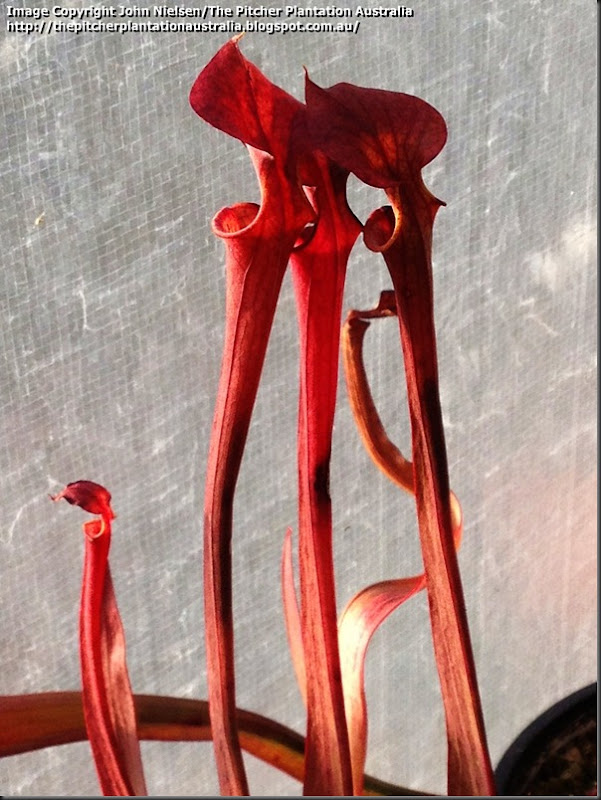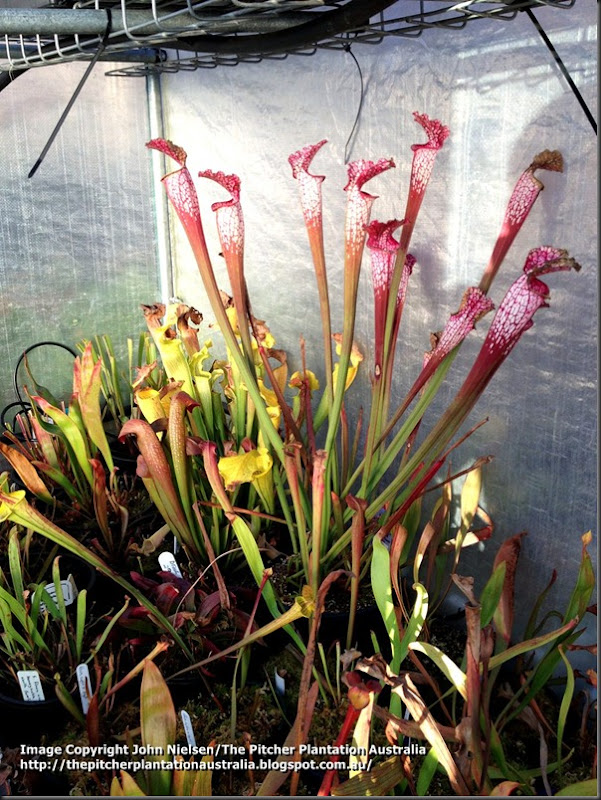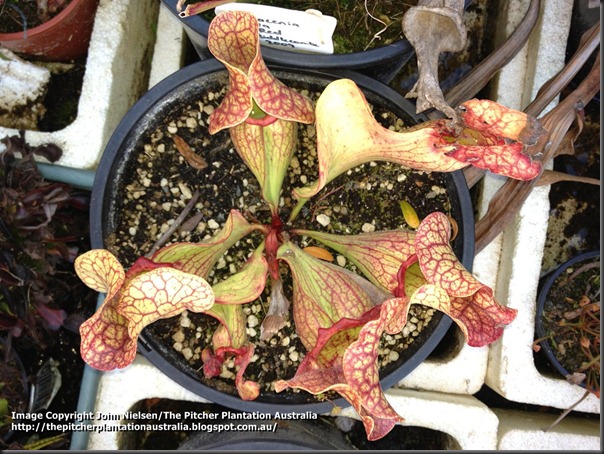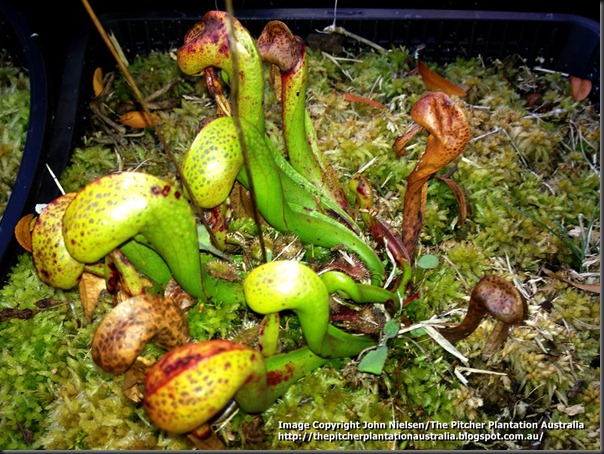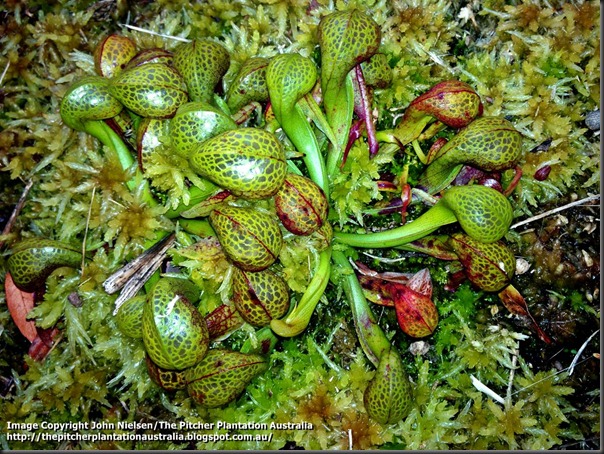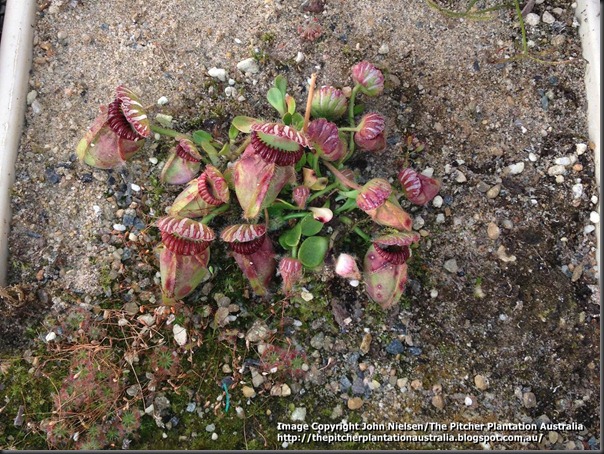Winter arrived a little early this year. Normally, the cold starts in early May, but this year we had two days of frost immediately after Easter, complete with snow in the Tinderry Ranges (30 km south of us) on the night of Easter Monday (9th April) and frost here the following two mornings. The plants normally go dormant before the cold and, true to form, they were down in late March. Here is the greenhouse collection as of yesterday evening, trimmed and ready for the winter. Compare with the collection in full growth earlier this year:
Despite the start of winter, a few plants still have reasonable pitchers…
This plant is a newcomer, originating from my visit to Gotcha! Plants last Christmas. It is a S. flava var. rubricorpora whose lid becomes nearly entirely red. I am increasingly of the opinion that S. flava var. atropurpurea is polyphyletic (ie. consists of several taxonomic lineages) in the context of its entire range – Carolina plants seem to be extremely red versions of S. flava var. cuprea, while Gulf Coast plants seem to be extreme forms of S. flava var. rubricorpora. Evidence for this comes from the way the lids fill in as the pitcher opens – plants of Carolina ancestry have a lid that is all red when the pitcher opens, while Gulf Coast plants are like S. flava var. rubricorpora, with the lid subsequently filling in to become all red. A third version of S. flava var. atropurpurea are extreme plants of S. flava var. ornata that similarly fill in to become all red. I have examples of all such plants in my collection.
Here is another S. flava var. atropurpurea. This clone comes from Phillipe Reytter of Lithgow, NSW. These pitchers are some 40 cm tall – they are really quite spindly compared with other clones, as the width of the pitchers stays very narrow indeed. Despite having grown this plant for 4 years now, I have not managed to get bigger pitchers out of it (even though they do fill up with insects). I have crossed it with S. flava var. atropurpurea '”FRT 1-1”, and will sow the seeds later this winter.
Plenty to look at here! This S. leucophylla is one from Gotcha! Plants, also in its 4th year in my collection. It is a reasonably tall plant, probably because its parent produces pitchers that are well over 1 metre tall! It is a very vigorous clone that divides very readily. Behind it is one of two S. alabamensis ssp. alabamensis clones I grow (you can see a dedicated entry for this plant here). In front is a S. minor I call “uber giant”, as it grows the largest pitchers of any S. minor I have seen in cultivation to date. Next to it is a form of S. oreophila I call “Grumpage”.
This hybrid of unknown parentage (?S. x moorei?) is spectacular for its ruby red pitchers. It has done magnificently this season and I am looking forward to seeing its progress next year.
The origin of this lovely S. rosea is somewhat of a mystery. Ron Abernethy found it one year at Triffid Park and grabbed it, recognising it as something unusual. He has never seen it in anyone else’s collection since, and Triffid Park have never had it again. It is not as strong a grower as some of the other S. rosea I have – Gotcha!’s stock standard S. purpurea (=S. rosea) is the best grower of all the S. rosea clones I grow. It is the only really heavily veined clone I know of.
In early January, I depotted one of my Darlingtonia and split it up for sale. In the process, I took some stolon cuttings just to see how they would go. I simply cut the stolon into inch long segments and buried them under maybe 1 cm of Sphagnum. Here is the result! Interestingly, one cutting produced mature-type pitchers after its second leaf, while the plant at right is producing only immature pitchers. Interesting indeed…
This is Darlingonia californica from Lake Wohink (seed grown by Ron Abernethy, via Triffid Park). It is a lot lighter green in colour than my other Darlingtonia clones, but still only small. I have no problem growing them here, even though Summer temperatures regularly pass 30*C (100*F). This plant was grown in full sun all summer. It seems that they need cool night temperatures to do well – it is rare to get a night over 18*C here. If it was not for the need to heat in winter, I’d grow highland Nepenthes here.
And another Darlingtonia, in this case, seedlings from Jessica Biddlecombe (who was sent seed by Barry Rice). These plants are still also small, but show a lot more colour than my other clones. These should be lovely when they are fully grown.
And just to finish off, here is a Cephalotus. Even though Canberra gets down to –8*C on occaision, Cephalotus can be grown here in unheated greenhouses. I have had this plant also for 4 years, and it has taken the cold in its stride without difficulty. Note the Drosera paleacea ssp. paleacea that are gradually populating the pot from their gemmae.
